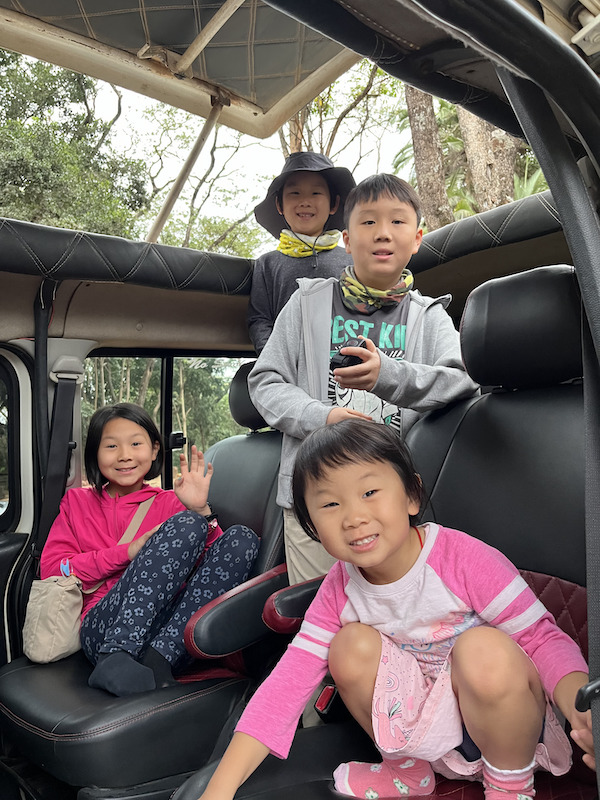We booked a morning safari in Nairobi National Park. DY has created a post with information about Nairobi National Park here.
Even though we would be going to Masaai Mara in a matter of days, we were eager to see animals. It was the first safari that we experienced as a family. Leo and I were in South Africa many years ago and greatly enjoyed the safari experience in Sabi Sands, next to Kruger National Park. We hoped our kids would love it too.
If the tour was just riding in the safari vehicle, it would have been enough for them. They were thrilled that the top popped open and they were encouraged by the guide to stand up, even while the vehicle was moving. The open top provides an unobstructed 360 degree view of the landscape and animals.
The first stop in Nairobi National Park was an ivory burning site and monument where tons of illegal ivory was burned, first in 1989 and most recently in 2016. It was impactful and strangely ironic to see large piles of ashes that were once the tusks of majestic elephants reduced to nothing but pebbles and dust as a protective measure against the greed of man.
Our guide said something that caught our kids’ attention, “Elephants are more valuable alive than they are dead”. Poachers kill elephants for their tusks because ivory is valuable. However, wildlife is not only the pride of Kenya, it is also a massive source of income for the country, contributing over 10% of the country GDP (Annual Tourism Sector Report – 2022. Ministry of Wildlife, Tourism and Heritage. Page 4. https://www.tourism.go.ke/wp-content/uploads/2023/02/ANNUAL-TOURISM-SECTOR-PERFORMANCE-REPORT-2022-2.pdf). The ivory burning site shows Kenya’s commitment to wildlife conservation and zero tolerance to the ivory trade.
In our following discussions about illegal poaching, we wanted to teach the kids about the complex web of motivations, incentives and consequences that causes such environmental destruction. It isn’t as simple as blaming the poachers. Although the poachers are the ones who commit the brutal act of killing the animals and must bear some responsibility, the problem is much more complicated than that. We watched some videos and did some online research about the illegal ivory trade and learned about the motivations of the poachers, the involvement of corrupt high-level officials who fund or arm the poachers, the profit involved for illegal traders, the skyrocketing demand of ivory and rhino horns from Asian countries (specifically China and Vietnam) that all leads to the destruction of an entire species. On the positive side, we learned about the individuals, communities and countries who try to put an end to illegal poaching, the challenges they face and the progress that they have made.
The next few hours were filled with animal spotting. The park contains four of the Big 5 (lions, leopards, buffalo and rhino but no elephants) and it was a pretty good day for game viewing. We kept a tally of the animals that we saw and here is the bar chart that DY made when we got home. We fibbed a little on the numbers for the zebra and impala viewings and just assigned them an arbitrary number (20) because they were just too plentiful that we stopped counting. We plan to keep a record of the animals we see on future game drives so we can do some data analysis.
Our guide was able to get us close enough to some animals to see them just a few meters away. For the ones that we spotted at a distance, we were able to use our binoculars to see them clearly. DY mentioned that we could put the lens of our phone camera onto the binocular lens to take better pictures. We tried it and found that it actually worked. All of the photos that have the round border surrounding the image are taken using this method. I was curious how he knew that and he said that his friend Z told him. Thanks Z!
The game drive at Nairobi National Park was certainly a highlight in Nairobi. The other “wild animal parks” that we have been to in other countries pale in comparison to this one. It is unbelievable that wild animals can roam free in their natural environment in such close proximity to the bustling capital city of Nairobi.
Author
-

Song is the mother of four children. She and her family have stepped away from it all and in September 2023, began traveling the world while homeschooling. Song is an ABC (American born Chinese) and has an undergraduate degree from Cornell and an MBA from Harvard. She is an entrepreneur and an educator. Her hobbies include learning, traveling, reading, cooking and baking, and being with children.


Wow, amazing! Did you bring your own binoculars? I like your writing a lot!
What a wonderful experience that you learn about different environmental, cultural issues and you are right there on site!! Learning from locals first hand must be such eye opening moments and inspire much deeper connections to the matter. I learned a lot just reading about it. Thank you for sharing!
I remembered that you mentioned seeing white rhinos in your postings. Here’s an article from National Geographic for your reference:
“ There are two northern white
rhinos left on Earth. Can a
controversial approach save
them?”
(I could not post pictures here, so only provided its title.)